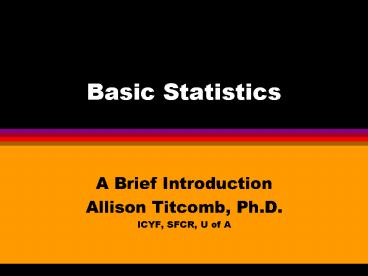Basic Statistics - PowerPoint PPT Presentation
1 / 22
Title:
Basic Statistics
Description:
Basic Statistics. A Brief Introduction. Allison Titcomb, Ph.D. ICYF, SFCR, U of A. Types of Data ... Qualitative (nominal and ordinal) vs. Quantitative ... – PowerPoint PPT presentation
Number of Views:4974
Avg rating:3.0/5.0
Title: Basic Statistics
1
Basic Statistics
- A Brief Introduction
- Allison Titcomb, Ph.D.
- ICYF, SFCR, U of A
2
Types of Data
- Stevens Levels (Scales) of Measurement
- Nominal (Categories)
- Numbers indicate difference in kind
- e.g., ethnicity, gender, ids
- Ordinal (Ordered)
- Numbers represent rank orderings distances are
not equal (e.g., grades, rank orderings on a
survey)
3
Stevens Levels cont.
- Interval
- Equal intervals, arbitrary zero
- Ratios have no meaning
- e.g., temperature in degrees F
- Ratio
- Equal intervals, absolute zero
- Equal ratios are equivalent
- e.g, weight, height
4
Other Types of Data
- Qualitative (nominal and ordinal) vs.
Quantitative (interval and ratio) - Discrete (finite number of values) vs.
Continuous (can potentially take on any numerical
value) - Dichotomous (only 2 values)
5
What kind of data are these?
- Number of crimes in a county
- Religious preference
- Pass/Fail on a test
- Income
- other examples?
6
Data Reduction
- Descriptive Statistics a.k.a. Summary Statistics
- numbers that represent some characteristics of
the set of scores - unorganized gt organized
- graph, shape
7
More data reduction
- Frequency Distributions
- bar diagram/histogram
- discrete vs. continuous data
- nominal level
- (ordinal data-- why dont you graph it?)
8
More data reduction
- frequency distributions
- interval/ratio
- shapes include skewed, bimodal, j shaped
- (See samples on board/overhead)
9
More data reduction
- Measures of Central Tendency
- describing and typifying
- used for comparison
- Mean (typical/average score, sensitive to extreme
scores) - Median (middlemost score)
- Mode (most common score)
10
More data reduction
- Measures of Variability
- dispersion/degree of heterogeneity
- Range
- Variance (degree of variability of individual
scores) - Standard Deviation (sq. root of variance typical
distance between individual scores and the mean
of the sample)
11
More data reduction
- Things that contribute to variability
- natural variability (true variance, tough to
measure) - sampling error
- measurement error
- systematic variance
- MAX MIN CON
12
More data reduction
- Normal Curve
- With large numbers, many things are normally
distributed - majority of individuals measured are clustered
close to the mean - symmetric mean, median, mode at same point
range is approx. 6 standard deviations
13
More data reduction
- Measures of relationship
- Pearsons Product Moment Correlation, more fondly
known simply as r - Correlation coefficient
- 2 sets of scores question is the relationship
between the 2. Is there a relationship? - Allows us to predict reliability
14
Correlation
- Describing the relationship
- Direction
- positive (high w/high, low w/low)
- negative (low w/high, high w/low)
- Magnitude
- 1.0 vs. -1.0
- low correlation, no correlation
- Draw a picture a.k.a. scatterplot
- Assumption is that it is Linear
15
Inferential Statistics
- Statistics in never having to say youre certain
judgment/ leap/ inference generalization - population parameters and sample statistics
- based on probability (relative frequency of
occurrence of an event in the long run)
16
Inferential Statistics
- Errors in Statistical Reasoning
- Null hyp-- no difference hypothesis
- Types of Errors (See Handout)
- Type I
- rejecting the null when its true
- crying wolf/false alarm/trigger happy
- in law, we dont want to convict innocent
- controlled by alpha level (e.g., 0.05)
17
Inferential Statistics
- Type II
- NOT rejecting the null when its wrong
- nice puppy as the wolf bites your fingers
- In medicine, wed rather treat someone who isnt
sick than to NOT treat someone who is (HMOs might
change that) - Beta, effect size, power of a test, alpha level
18
Inferential Statistics
- Major types of statistical tests
- Dont forget Whats the question?
- t test (or t-test statistic) two means
- t for two Gossett at Guiness Students t
19
Inferential statistics
- F test
- for more than two means
- a t test is a baby F test
- btwn/within Fisher an agrarian researcher (ever
heard of a split plot design?) - interactions
20
Inferential Statistics
- Chi square
- nominal data (e.g., democrats and republicans
males and females) - Correlation
21
Inferential Statistics
- Statistical vs. Practical Significance
- Cost/Benefit question-- Ask Compared to What
- Statistically significant other?
- Significant findings do NOT eliminate the need
for replication
22
Inferential Statistics
- p 0.0001 vs. p 0.01 NOT effect size
- Non significant findings often do not get
published-- bias in literature?































